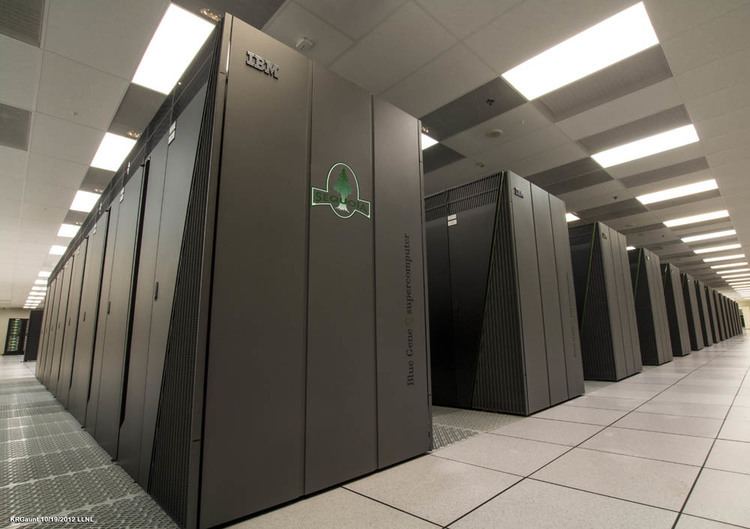Operators LLNL Memory 1.5 PiB | Power 7.9 MW | |
 | ||
Location Livermore, California,
United States Operating system Space 3,000 square feet (280 m) | ||
IBM Sequoia is a petascale Blue Gene/Q supercomputer constructed by IBM for the National Nuclear Security Administration as part of the Advanced Simulation and Computing Program (ASC). It was delivered to the Lawrence Livermore National Laboratory (LLNL) in 2011 and was fully deployed in June 2012.
Contents
On June 14, 2012, the TOP500 Project Committee announced that Sequoia replaced the K computer as the world's fastest supercomputer, with a LINPACK performance of 16.32 petaflops, 55% faster than the K computer's 10.51 petaflops, having 123% more cores than the K computer's 705,024 cores. Sequoia is also more energy efficient, as it consumes 7.9 MW, 37% less than the K computer's 12.6 MW.
As of June 17, 2013, Sequoia had dropped to #3 on the TOP500 ranking, behind Tianhe-2 and Titan. In June 2016, it slipped again, to fourth place on the TOP500 ranking.
Record-breaking science applications have been run on Sequoia, the first to cross 10 petaflops of sustained performance. The cosmology simulation framework HACC achieved almost 14 petaflops with a 3.6 trillion particle benchmark run, while the Cardioid code, which models the electrophysiology of the human heart, achieved nearly 12 petaflops with a near real-time simulation.
The entire supercomputer runs on Linux, with CNK running on over 98,000 nodes, and Red Hat Enterprise Linux running on 768 I/O nodes that are connected to the Lustre filesystem.
Dawn prototype
IBM built a prototype, called "Dawn," capable of 500 teraflops, using the Blue Gene/P design, to evaluate the Sequoia design. This system was delivered in April 2009 and entered the Top500 list at 9th place in June 2009.
Purpose
Sequoia will be used primarily for nuclear weapons simulation, replacing the current Blue Gene/L and ASC Purple supercomputers at Lawrence Livermore National Laboratory. Sequoia will also be available for scientific purposes such as astronomy, energy, lattice QCD, study of the human genome, and climate change.
Node architecture
Sequoia is a Blue Gene/Q design, based on previous Blue Gene designs. It consists of 96 racks containing 98,304 compute nodes, i.e., 1024 per rack. The compute nodes are 16-core A2 processor chips with 16 GB of DDR3 memory each. Thus, the system contains a total of 96·1024·16 = 1,572,864 processor cores with 1.5 PiB memory. It covers an area of about 3,000 square feet (280 m2). The compute nodes are interconnected in a 5-dimensional torus topology.
Job scheduler
LLNL will use the SLURM job scheduler, which is also used by the Dawn prototype and China's Tianhe-IA, to manage Sequoia's resources.
Filesystem
LLNL uses Lustre as the parallel filesystem, and has ported ZFS to Linux as the Lustre OSD (Object Storage Device) to take advantage of the performance and advanced features of the filesystem.
In September 2011, NetApp announced that the DoE had selected the company for 55 PB of storage.
Power usage
The complete system will draw about 6 MW of power but is projected to have an unprecedented efficiency in performance per watt. The Sequoia design will perform 3000 Mflops/watt, about 7 times as efficient as the Blue Gene/P design it is replacing, and more than 3 times as efficient as a prior (June 2011) Top 500 leader.
Application
In January 2013, the Sequoia set the record for the first supercomputer using more than one million computing cores at a time for a single application. The Stanford Engineering's Center for Turbulence Research (CTR) used it to solve a complex fluid dynamics problem – the prediction of noise generated by a supersonic jet engine.
